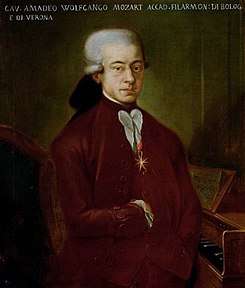Piano Sonata No. 6 (Mozart)
Wolfgang Amadeus Mozart's Piano Sonata No. 6 in D major, K. 284 / 205b, (1775) is a sonata in three movements:
- Allegro D Major, 4/4
- Rondeau en polonaise (Rondo and Polonaise), Andante A Major, 3/4
- (Andante) D Major, 2/2
| Piano Sonata in D major | |
|---|---|
| No. 6 | |
| by W. A. Mozart | |
 The young composer, a 1777 copy of a lost painting | |
| Key | D major |
| Catalogue | K. 284 / 205b |
| Style | Classical period |
| Composed | 1775 |
| Dedication | Baron von Dürnitz |
| Movements | Three (Allegro, Rondeau en polonaise, Tema con variazione) |
A typical performance takes about 20 to 25 minutes.
This piano sonata is the last of the sonatas that Mozart published in Munich. The piece is subtitled "Dürnitz" as it was written for Baron von Dürnitz, an amateur bassoonist and keyboard-player, who failed to pay for the work. The work was written down during the visit Mozart paid to Munich for the production of La finta giardiniera from late 1774 to the beginning of the following March. The autograph and the first edition of the sonata have numerous inconsistencies.
Allegro
A first version of the beginning of the first movement, written on one and a half pages, was cancelled by Mozart. On the same page, he started anew to write the final version underneath. The thematic material of this opening movement (and to a lesser degree also that of the following movements) is laid out on a more ample, nearly orchestral scale, a departure from the intimacy of the early sonatas. The tremolo effect in measures 13-16 and the unison announcements of the first subject read very much like a piano reduction of an orchestral tutti. The second subject, a supple melodic line, unaccompanied in its opening bar, incorporates a descending chain of first inversions, a favourite harmonic formula of the baroque and classical periods. (There are analogous passages in the subsidiary themes in Gluck’s overture Iphigénie en Tauride and the first movements of J. S. Bach’s Italian Concerto). This functions as a solo passage in contrast to the ensuing tutti entries in m.30. The development moves through a circle of minor keys before the recapitulation begins in measure 72.
Rondeau en polonaise (Rondo and Polonaise)
Mozart called the second movement a Rondeau en Polonaise, and it is hence a dance. The opening four measures from a kind of dialogue (like the theme of the first movement of the preceding G Major Sonata), and Mozart subjects them to felicitous counter-statement is heightened by Mozart's meticulous dynamic markings.
Tema con variazione (Theme with variations)
The last movement of the Sonata is a simple theme followed by twelve variations upon said theme, which, up to the tenth variation, has the character of a gavotte. The theme is marked 'Andante' in the first edition (published during Mozart's lifetime), but has no indication in the autograph. The theme and the first eleven variations are in cut time, with the first 10 in the tempo of the theme. The eleventh variation is marked Adagio cantabile in the first edition and the autograph. The twelfth and final variation is marked Allegro in the first edition only and is in 3/4 time. All variations except for the seventh are in D major; the seventh is in the parallel D minor.
This movement shows Mozart’s special gift for writing variations at its most brilliant. The superficial impression of a diffuse form does not stand up to a closer inspection: it would not be at all easy to omit one of the twelve variations, or to add an extra one. The eleventh variation is of special interest to Mozart scholars, for it gives us some insights into his concept of impromptu ornamentation. The autograph is only modestly ornamented, and Mozart presumably embellished it in performance as his fancy dictated. But a richly ornamented version survived in the first edition, and this embellished version is most likely Mozart’s own work.
External links
- Sonate in D KV 284: Score in the Neue Mozart-Ausgabe
- Piano Sonata No. 6: Scores at the International Music Score Library Project (IMSLP)
- http://imslp.org/wiki/Piano_Sonata_No.6_in_D_major,_K.284/205b_(Mozart,_Wolfgang_Amadeus)
- http://www.henle.de/us/detail/index.html?Title=Piano+Sonata+D+major+K.+284+(205b)_1063